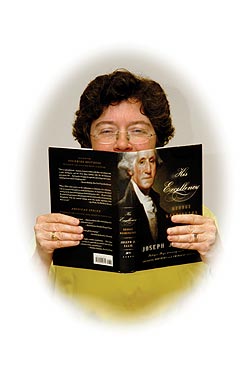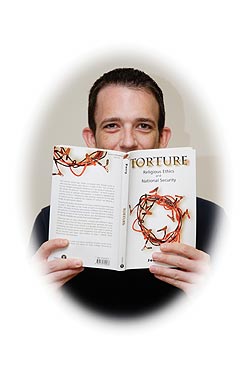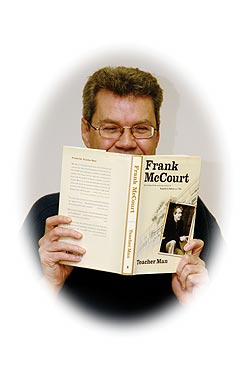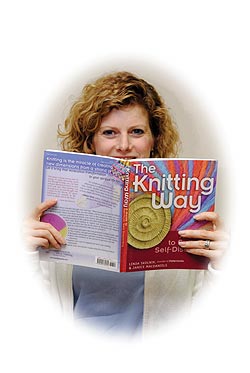
Editors always seem to have their noses in a book, and the U.S. Catholic editors are no exception. Here’s what we’ve been reading lately.
 Megan Sweas
Megan Sweas
Assistant editor
Karen Armstrong was “withdrawn, bitter, weary, frightened, and ill” for much of her life, she admits in the preface to her memoir, The Spiral Staircase: My Climb Out of Darkness (Anchor, 2005).
Despite this intimidating beginning, Armstrong’s book is satisfying and enlightening because she deals so honestly with suffering, which she notes “is an inescapable fact of human life.”
The book is the sequel to Through a Narrow Gate (St. Martin’s Press, 1981), Armstrong’s story of her seven years as a young nun. The Spiral Staircase can be read alone, however, as the preface gives sufficient background on her years in the convent. It also benefits from the perspective Armstrong has gained over time.
Armstrong says that her first attempt to write a sequel, Beginning the World (St. Martin’s Press, 1983), was a flop. She portrayed herself “as positive and lively” in the now out-of-print book, trying to convince herself and her audience that she had successfully rejoined the secular world.
The Spiral Staircase, in contrast, has become a bestseller precisely because Armstrong openly discusses her failures and fears in it. She shares her struggles—social insecurities, health problems, professional stumbling blocks, and loss of faith in God and the church—after leaving the convent in 1969.
Each setback, however, leads to a new opportunity to grow, eventually allowing her to find God and her place—no longer a nun and yet not fully a “secular” either—while researching and writing A History of God (Ballantine Books, 1994).
Armstrong’s fluid writing and vast knowledge of poetry and religion allows readers to become engrossed in the story and grow alongside her. Although suffering is a universal theme, so too is the power of compassion, silence, and hope, which we discover with Armstrong as she climbs her unique spiral staircase toward the light.
 Bryan Cones
Bryan Cones
Associate editor
If someone were to suggest that healing the divisions within the Catholic Church was akin to breeding pandas, they’d probably be judged unbalanced. Yet that is precisely what Father Timothy Radcliffe, O.P. suggests in What Is the Point of Being a Christian? (Continuum, 2005) in the title of his second-to-last chapter, and he is anything but.
Radcliffe does far more, though, than offer a diagnosis (“root shock”) and cure (conversation) for what ails the church. Rather, he makes a case for a Christianity that is both attractive and compelling, arguing for believers who are free, spontaneous, playful, and open to the world around them. His advice to the baptized is, of all things, to be ourselves: “In a culture that is in many ways anti-body, through its trivialization of sex and its cultivation of unlimited desire, we may begin by accepting to be the bodies that we are, thin and fat, young and old, male and female, mortal.” It is, after all, our bodiliness that God came to share in the Incarnation.
Though Radcliffe’s counsel may sound simple, his presentation is both wide and deep, touching everything from human relationships and sexuality to our current free-market political and economic order. Most compelling is his identification of our current culture’s anti-Trinity: “the cultivation of limitless desire, the absolutization of private property, and the deification of money.” Rather than leave us hopeless in the face of such demons, however, Radcliffe lights a path out, drawing on the rich resources of Catholic tradition.
The sheer breadth of the issues Radcliffe chooses may seem daunting. He also may be rightly accused of name-dropping, from the literary likes of Virginia Woolf to intellectual powerhouses such as political scientist and historian Francis Fukuyama. Yet Radcliffe’s invocation of such genius only sharpens his credibility: Here is a man who has seriously engaged the world around him, both learning from it and offering a confident critique. At the same time, Radcliffe’s sharing of stories from his travels, especially from his time as Master General of his Dominican order, and his light-hearted, accessible writing, turn what could be a rough read into a real pleasure.
What is the point of being a Christian? While not even attempting to be the last word, Radcliffe certainly provides the beginning of an answer, one both hopeful and inspiring. As for the panda breeding project, I’ll leave it to Radcliffe to make the case himself.
 Cathy O’Connell-Cahill
Cathy O’Connell-Cahill
Senior editor
On the Mall in Washington, D.C., the words of Jefferson and Lincoln proudly adorn their memorials: “We hold these truths to be self-evident . . . ” “With malice toward none, with charity toward all . . . ” The Washington memorial, however, is essentially word-free. “Jefferson was like one of those dirigibles at the Super Bowl, flashing inspirational messages to both sides. Washington was aloof and silent, like the man in the moon,” writes Joseph Ellis in His Excellency: George Washington (Knopf, 2004).
This readable book succeeds in humanizing this most distant of the Founding Fathers. Tightly focused on Washington’s character, the book explains why Franklin, Jefferson, Adams, Hamilton, and Madison each thought Washington to be the only indispensable figure. Physically imposing at 6 feet, 2 inches, he often remained silent at political gatherings. This made him appear wise and above the fray, but most likely arose from the fact that, as a self-educated man, he felt he would be out of his depth with the college-educated men around him. He had learned, too, to lead by listening.
Ellis tackles the slavery question head-on: On one hand, Washington freed his slaves in his will but not during his lifetime; on the other, he refused to split up slave families, which by the 1780s meant that Mount Vernon made no profit and had become a “retirement home and child-care center for many of his slave-residents, whom he was morally obliged to care for.” A complicated human being like the rest of us—not the man in the moon after all, thank goodness.
 Santiago Cortés-Sjöberg
Santiago Cortés-Sjöberg
Bilingual associate editor
The torture of prisoners at the hands of American soldiers and contractors at Abu Ghraib prison brought home what many in this country thought only happened abroad in oppressive or tyranical countries. The recent investigations into CIA prisoner transfer flights and the Supreme Court’s decision against the military tribunals proposed by President Bush, have kept the issue of prisoners’ rights in the headlines. John Perry’s Torture: Religious Ethics and National Security (Orbis, 2005) timely addresses the issue of torture from a Catholic perspective. The author builds on the history, arguments, and experiences of torture to show that it is an intrinsically immoral act.
Perry, a Jesuit professor of ethics, first leads us through a history of torture, including the Catholic Church’s use of torture during the Spanish Inquisition, the notorious practices of Augusto Pinochet’s Chilean dictatorship, and the current war on terror. The author explains why torture is different from other warlike actions and analyzes the different arguments used to sanction its use. Within this context, the author presents an overview of the Catholic understanding of torture, explaining its evolution through the centuries.
Going beyond the effects of torture on individuals, Perry argues that torture also “degrades any society that would tolerate it,” a clear call to us to “speak out against torture and defend human rights.” The final chapter raises the question of whether there can be justice and forgiveness in the realm of torture. Perry relies on numerous personal testimonies to argue that he believes that recovery from torture is “not primarily a medical or psychological process but a spiritual one.”
Perry’s book provides a well-built and easy to understand argument against torture from a Catholic and, I dare to say, human perspective. He never shies away from calling torture by its name, even when addressing the church’s use of it in centuries past. The personal accounts of victims and torturers that illustrate each chapter contain at times very graphic and disturbing descriptions of torture episodes which, while a sensitive reader might choose to skip them, are invaluable in providing a vivid face of what is a foreign reality to many of us. Well worth reading, this book will move readers’ hearts, and I hope will encourage them to protect human rights, whether abroad or in this country.
 John Molyneux
John Molyneux
Editor
Before he burst on the literary scene at the age of 66 with Angela’s Ashes (Scribner, 1996), the Pulitzer-Prize-winning memoir of his childhood in Limerick, Ireland, Frank McCourt spent 30 years teaching English in New York City high schools. In Teacher Man (Scribner, 2005), he recounts the trials, triumphs, and surprises of that “first act” of his life with an irreverent wit, dark humor, and unflinching honesty.
McCourt’s rocky marriage, his failed attempted to get his Ph.D. at Trinity College, Dublin, and his repeated firings due to his propensity to talk back to his superiors ironically lead him to New York’s most prestigious school, Stuyvesant High School, where he finally finds a place and a voice.
Having spent a short stint myself as a junior high teacher in East Harlem, I identified readily with his struggles to gain the attention and respect of unruly, hormonally charged, or indifferent adolescents. I marveled at McCourt’s unconventional methods and imaginative assignments (he instructs one class to write “An excuse note from Adam or Eve to God”) that help create a lasting impact on his students. It was these students who first recognized what literary critics later called “a master storyteller.” And it was these students who first encouraged him: “Hey, Mr. McCourt, you should write a book.”
 Heidi Schlumpf
Heidi Schlumpf
Managing editor
If you think knitting is just for grannies in rocking chairs, you must have missed that it has become one of the hottest hobbies not only for women in their 20s, 30s, and 40s, but also for teens and some men. A few years ago the media termed it “the new yoga.” What knitting also shares with that trendy physical workout is that they both can be a spiritual practice as well.
In The Knitting Way (Skylight Paths, 2005), authors Linda Skolnik and Janice MacDaniels argue that knitting is all about connection—not only physically connecting loops of yarn with needles but inner and outer connections as well. As a repetitive practice, knitting can be meditative and lead us to the divine; as a creative practice, it can help us learn about ourselves. And as a craft with a long history, mostly among women, it connects us to a community of knitters, both past and present.
Like any meditative practice, knitting can lead to spiritual insights and truths. Finishing a scarf despite a dropped stitch teaches the need to let go of perfection and accept life as it is. Tackling a more difficult pattern shows how taking life one step at a time can get us through trying times. (“Just take it one row at a time,” my mother always says, echoing the 12-step mantra.) The physical rhythm of “knit two, purl two” for ribbing both quiets the mind and highlights the mind/body connection.
But it is knitting as a doorway to spiritual community through storytelling that most excite Skolnik and Janice. Not only does each knit item tell a story, but thousands of knitters now connect with one another through knitting guilds, charity groups, “Stitch ’N Bitch” groups, and on knitting blogs. (Visit mine at spiritualknitter.blogspot.com.)
“Community is a place where we are welcome to just be, to share burdens and joys and to support those who, for a time, might be just a little weaker,” the authors write. “It’s a place to share, gain wisdom, learn, and teach, and it provides immeasurable opportunity for the making of mentors.”
The Knitting Way is not the best written book on the deeper side of knitting, and there are others, such as Mindful Knitting and Compassionate Knitting (Tuttle Publishing, 2004, 2005, respectively), both by Tara Jon Manning, which look at knitting in a Buddhist context. But this book does introduce the idea of spiritual knitting well and offers some interesting patterns, too. Women have been making connections between the spiritual and the everyday since the beginning of time. We shouldn’t be surprised that they are now seeing a relationship between purling and prayer.
 Tom Wright
Tom Wright
Art director
A few years ago, while hiking in the Wind River Mountains in Wyoming, I managed to get myself lost from my group. I made a series of bad decisions and spent a rainy night stretched out under a rock trying to stay dry and warm. The next morning, by sheer luck and a compass, I found my way back to the camp.
Deep Survival: Who Lives, Who Dies, and Why (Norton, 2003) by Lawrence Gonzales wouldn’t have helped me in surviving my ordeal, but it did help me recognize why, with all the outdoor experience I’ve had, I still managed to make so many mistakes in judgment. Gonzales uses case histories of people caught in avalanches, storm-wrecked at sea, lost in the freezing mountains, and even in the hell of 9/11 to illustrate how the human brain reacts to stress and why some have the mental or spiritual resources to survive while others perish.
In one example the author tells of a 51-year-old father out for a couple of hours of skiing in Squaw Valley, California. He gets caught in a whiteout at the top of the mountain and instead of staying put gets lost for three days, with nights dropping to 50 degrees below zero. At one point, with both feet frozen solid, he prays, “Dear God, take my feet, don’t worry about that, help me get through this thing.”
Even though you may never climb a mountain or try to cross the ocean in a sailboat, this book will change the way you view the everyday decisions you make in both your work and recreation. It has made me listen closer to that little voice in my head that sometimes says, “This might be a bad idea.”
This article appeared in the September 2006 (Volume 71, Number 9; pages 30-33) issue of U.S. Catholic.
